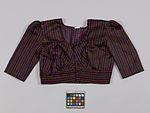palku (Blouse)
About this object
History of use
Blouses of this type were worn by women of the Hindu Koli caste. Members of that caste assisted in the production and gathering of this clothing. The cloth for the clothing was purchased in Kodinar town, 7 km. to the east of Dhamlej. Blouses of this type were also worn by women of other castes, including the Karadaya Rajput, Ahir, Dalit, and Rabari. Koli women wore distinctive jewellery, including small bracelets called bangli in Gujarati made of plastic or gold, silver ankle chains called chhdi, solid silver anklets called sakada, and large gold nose rings called kadi. Such blouses were also worn by women of other castes.
Narrative
Blouse was collected with the help of Hindu Koli people. This collection was gathered with the enthusiastic participation of villagers in Dhamlej, reflecting Derek Johnson’s rapport with them. They allowed him to take photographs of them demonstrating how the clothing is put on and worn. These photographs are available in the Museum of Anthropology collection documentation file for accession 2615.
Cultural context
daily use
Iconographic meaning
The type of clothing helps to communicate the caste of the wearer.
Specific techniques
Cut and machine-sewn by a tailor.
Physical description
Fitted blouse with scoop neck, three-quarter length sleeves and button down-front. The sleeves are puffed and the bottom is cut off just below the bust. The fabric is a navy blue polyester with pink and red banded stripes grouped in pairs alternating with bands of stylized orange flowers.
